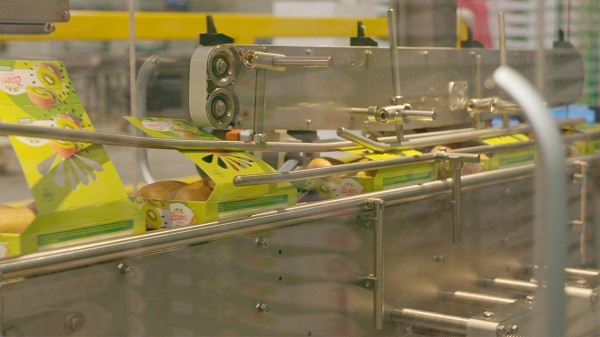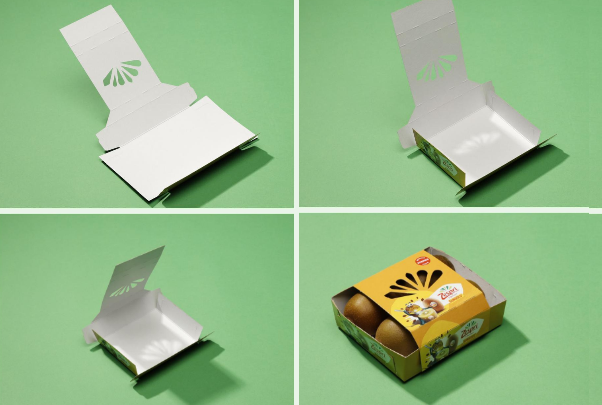One of Zespri’s global sustainability goals is to have its packaging be fully recyclable, reusable, or compostable by 2025. Recently, this kiwi specialist took a step in that direction in Europe by switching to consumer packaging made of 100% cardboard.

"We used to pack the fruit in a cardboard tray but still enclosed in a plastic film. Our company wholeheartedly supports sustainability. So, we want to rapidly move toward a plastic-free solution for our consumer packaging. We want to use entirely sustainable cardboard packaging," says Nele Moorthamers, Zespri's Head of Marketing Europe & North America.
Visibility
‟We focused mainly on whether the new packaging would fully support the fruit and ensure the kiwis are optimally packed and transported. The packaging had to suit a fresh product, ensuring its shelf life remains optimal while packaged. Plastic has an important function in terms of preserving fresh produce, and alternatives must be carefully evaluated."
Visibility was another aspect that was considered, of which there is less in cardboard packaging than in plastic. "Shoppers want to be able to see the product and judge what is the best fruit for them. So, we tried to make the fruit visible. By making the necessary cutouts in the packaging, we found the balance between visibility and sturdiness," Nele explains.
Red kiwi
Another aspect in which Zespri pursues sustainability is cultivation. For example, they are currently conducting trials growing red kiwis in Europe. Zespri already sells these in Asia. "We eventually want to bring red kiwis to the European market as well by growing the fruit there. That's closer and falls under our sustainability goals."
"We want to be able to cultivate our product as close to consumers as possible," Nele says. Like green and yellow kiwis, this variety will be packaged in the new cardboard tray too. "We will package it in the same way as our other kiwis. We’re trying very hard to reduce how much plastic we still use in packaging in Europe."
Positive feedback
Nele points out consumers also expect companies to move away from using plastic. "It’s slightly country-dependent, but people want to see less plastic packaging.” The market is receiving Zespri’s new packaging well. "Shoppers are responding very positively to it,” she says. However, due to rising prices - not only for paper and cardboard but many other raw materials - it is challenging to find a consumer price balance. "People are willing to pay good prices for quality products. So, we try to balance the higher costs and our consumer price."
Total concept
Before choosing this new cardboard packaging, Zespri did a market analysis to determine its options. "Introducing new packaging isn’t only about the packaging, but also about the technology around it. This must ensure cardboard boxes can be set up, folded, filled, and sealed,” says Melanie Vanbelleghem of Van De Velde Packaging. This Belgian company has worked with Zespri for years and set up the new packaging process.
"We’re a one-stop-shop. We not only have product knowledge but also know the packaging machines. We can use this expertise separately if needed." Melanie considers placing a complete process, from packaging to machines, with the same party as a major advantage. "We work together internally - the Packaging Department works with the Machinery Department - to see how any problem can be solved and how we can optimize the process."

"If those are separate players, communication is usually slightly harder." This total concept appealed to Zespri. "On the one hand, you have the new packaging, but how to use it? For us, it’s important that there’s a link to the machine, so we can eventually automate the packaging process," says Nele.
Moving toward cardboard
Melanie says there is much more market interest in paper and cardboard packaging than before. She attributes this to, among other things, legislation that has recently been passed in France. It bans plastic as a packaging material, with a few exceptions. "We think this trend will reach Belgium and the Netherlands too."
"Our customers are already shifting from plastic to cardboard packaging." It serves a company well to prepare for this switch, says Melanie. "It’s a big step for many clients to switch to paper or cardboard. It hugely affects their production process as well.”
Reduced volume
Cardboard prices have risen dramatically since last summer. And several cardboard factories have closed, either due to aging or as planned. That has led to a more limited supply of this material. "Much volume has, thus, disappeared from the market." The volume from factories now being newly built as replacements will probably not be available until later this year. They will also be running at full capacity to meet the current market demand, says Melanie.
And there is going to be new demand due to the shift from plastic to cardboard packaging. "So, the new factories opening won’t lead to a surplus. You can’t absorb a plant closure overnight; it takes time," she concludes. Because of this and rising energy prices, Melanie expects paperboard to remain pricier for now. Though she suspects producers will eventually ramp up capacity to provide opportunities to meet demand.
Nele Moorthamers
Zespri International (Europe)
Posthofbrug 10 bus 3
B-2600 Berchem
+ 32 3 201 08 05
nele.moorthamers@zespri.com
www.zespri.eu
